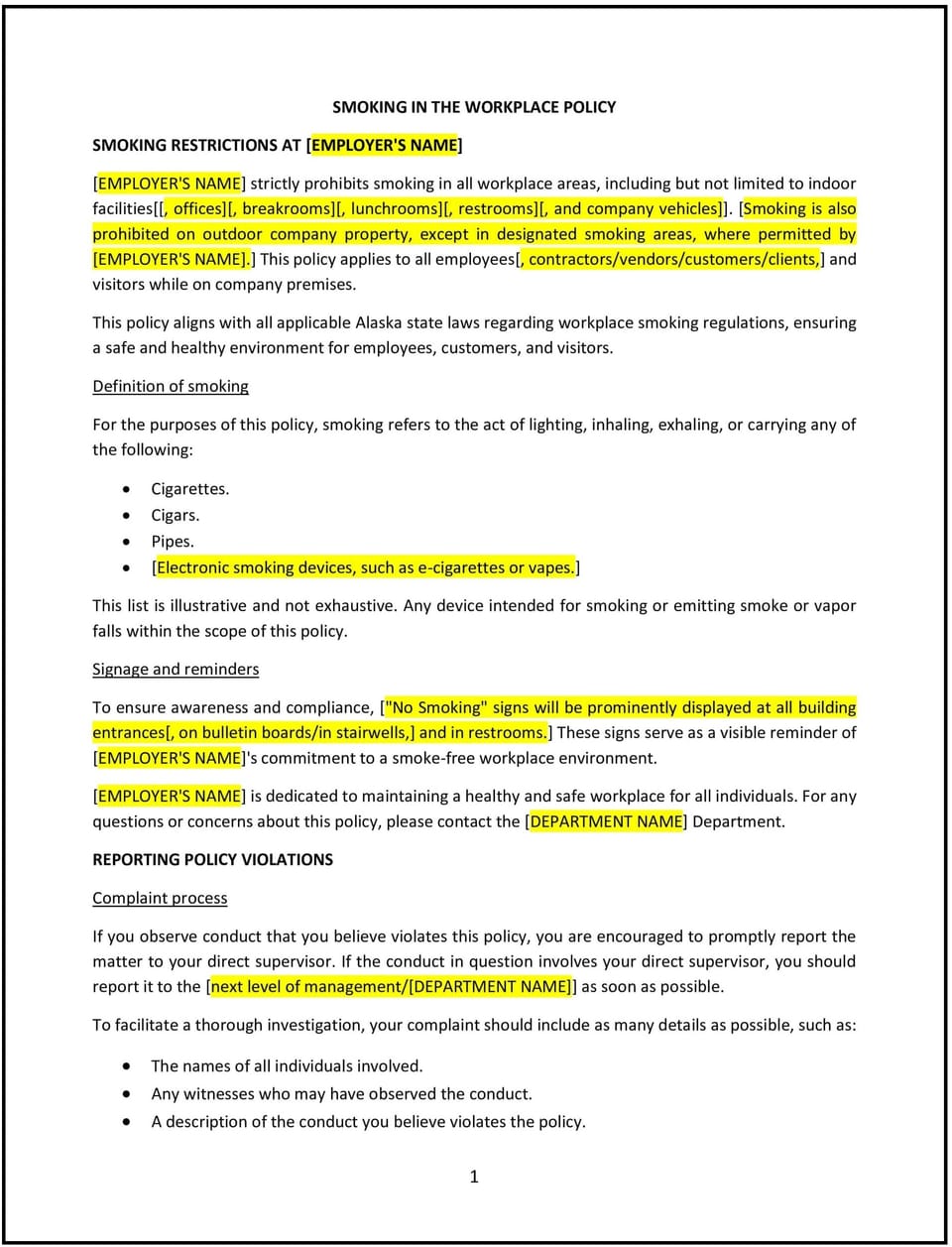Smoking in the workplace policy (Alaska): Free template

Smoking in the workplace policy (Alaska)
In Alaska, a smoking in the workplace policy establishes clear guidelines for smoking and vaping to ensure a safe, healthy, and compliant environment for all employees. This policy outlines designated areas, prohibits smoking in restricted zones, and aligns with state and local laws, such as the Alaska Smokefree Workplace Act.
By implementing this policy, businesses can protect employee health, reduce conflicts, and maintain compliance with regulations.
How to use this smoking in the workplace policy (Alaska)
- Define restricted areas: Specify where smoking and vaping are prohibited, such as indoor spaces, company vehicles, and entrances to buildings.
- Identify designated smoking areas: Provide clear instructions on where employees can smoke, ensuring these areas are compliant with local laws and away from shared workspaces.
- Address compliance requirements: Include details about applicable state and local laws, such as distance requirements from building entrances or air intake systems.
- Communicate expectations: Inform employees about the policy during onboarding and through visible signage in the workplace.
- Outline enforcement measures: Specify consequences for policy violations, such as verbal warnings, written notices, or other disciplinary actions.
Benefits of using a smoking in the workplace policy (Alaska)
A smoking in the workplace policy provides several advantages for businesses in Alaska. Here’s how it helps:
- Protects health: Reduces exposure to secondhand smoke for non-smoking employees, promoting a healthier workplace.
- Ensures compliance: Aligns with state and local laws, such as the Alaska Smokefree Workplace Act, minimizing legal risks.
- Reduces disputes: Provides clear guidelines to prevent conflicts between smoking and non-smoking employees.
- Enhances workplace safety: Reduces fire hazards associated with smoking in prohibited areas.
- Supports inclusivity: Accommodates both smokers and non-smokers through designated areas and clear communication.
Tips for using a smoking in the workplace policy (Alaska)
- Address vaping: Include specific guidelines for e-cigarettes and vaping to ensure consistency with smoking restrictions.
- Tailor for outdoor workplaces: For industries like fishing or construction, specify smoking guidelines that balance operational needs with employee health.
- Provide support: Offer resources for smoking cessation programs to support employees who wish to quit.
- Ensure proper signage: Post clear signs indicating designated smoking areas and restricted zones to reinforce compliance.
- Update regularly: Revise the policy as needed to reflect changes in laws, workplace dynamics, or smoking trends.
Q: Where are employees allowed to smoke under this policy?
A: Employees may smoke only in designated outdoor smoking areas that comply with local laws and are located away from entrances, windows, or ventilation systems.
Q: Does this policy cover vaping and e-cigarettes?
A: Yes, vaping and e-cigarettes are treated the same as traditional smoking under this policy and are subject to the same restrictions.
Q: How can businesses ensure compliance with the Alaska Smokefree Workplace Act?
A: Regularly review state laws, provide clear signage, and educate employees on prohibited areas and designated smoking zones.
Q: What steps can businesses take to support employees who wish to quit smoking?
A: Offer resources such as smoking cessation programs, counseling services, or reimbursement for cessation aids to encourage a smoke-free lifestyle.
Q: How often should this policy be reviewed?
A: Review the policy annually or whenever changes occur in state or local smoking regulations or workplace needs.
This article contains general legal information and does not contain legal advice. Cobrief is not a law firm or a substitute for an attorney or law firm. The law is complex and changes often. For legal advice, please ask a lawyer.


